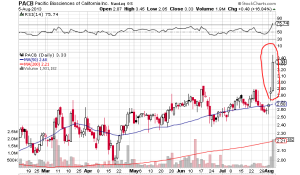
Large Jump in PacBio Stock Price
We made fun of PacBio stock price on the way down. Therefore, we have the responsible to point out, when it goes up.

Why is it going up?
Mainstream opinion - PacBio’s new release (RS II) is working very well in giving researchers long reads they need. For details, check the paper and discussion linked in this thread.

Contrarian view (proposed by only one analyst) -
Homolog.us blog finally figured out on late Friday, what went wrong with it’s data !!
Trials and Tribulations with PacBio Data
A Snapshot of How PacBio Reads Look Like
For those who are laughing, it is called ‘butterfly effect’.
In chaos theory, the butterfly effect is the sensitive dependence on initial conditions in which a small change at one place in a deterministic nonlinear system can result in large differences in a later state. The name of the effect, coined by Edward Lorenz, is derived from the theoretical example of a hurricane’s formation being contingent on whether or not a distant butterfly had flapped its wings several weeks earlier.
Although the butterfly effect may appear to be an esoteric and unlikely behavior, it is exhibited by very simple systems. For example, a ball placed at the crest of a hill may roll into any surrounding valley depending on, among other things, slight differences in initial position.
……
The butterfly effect is most familiar in terms of weather; it can easily be demonstrated in standard weather prediction models, for example.[5]
The potential for sensitive dependence on initial conditions (the butterfly effect) has been studied in a number of cases in semiclassical and quantum physics including atoms in strong fields and the anisotropic Kepler problem.[6][7] Some authors have argued that extreme (exponential) dependence on initial conditions is not expected in pure quantum treatments;[8][9] however, the sensitive dependence on initial conditions demonstrated in classical motion is included in the semiclassical treatments developed by Martin Gutzwiller[10] and Delos and co-workers.[11]